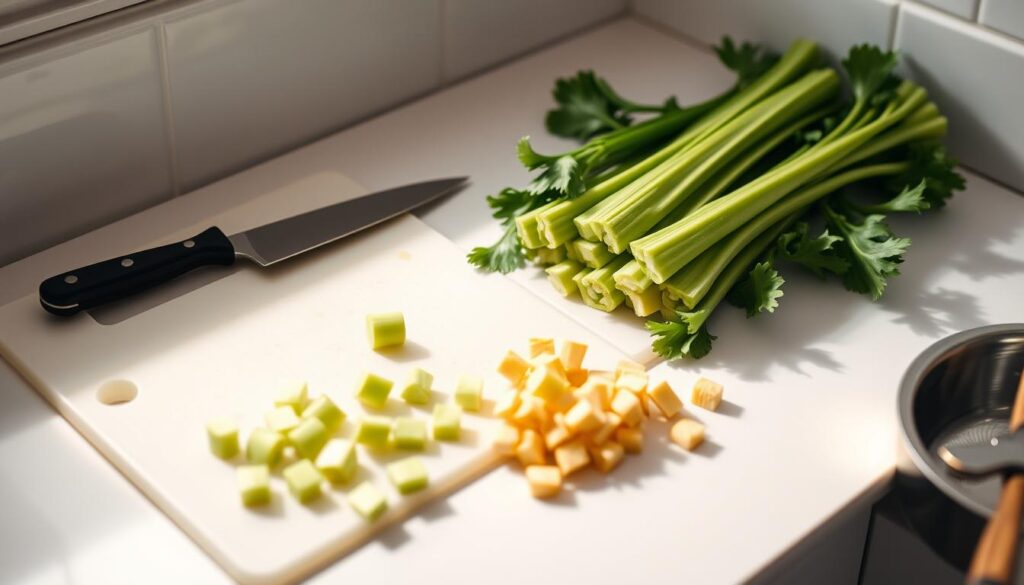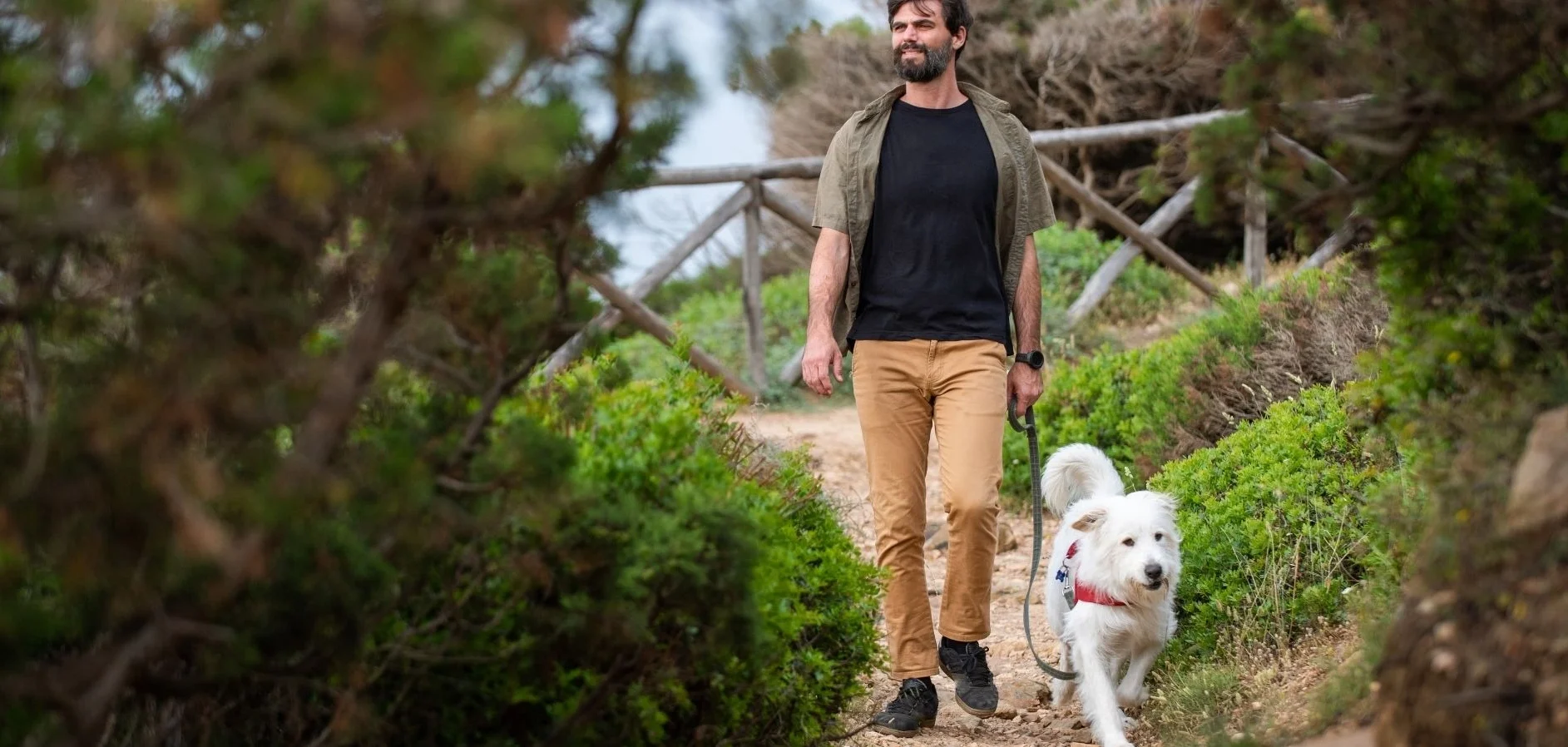Can Dogs Eat Celery? Read This Before You Feed Them!
Table of Contents
As a dog owner, I’ve always wondered about safe human foods for my pet. When I was chopping celery for lunch, my dog looked at me with hope. This made me think: can dogs eat celery?
Celery can be a great treat for dogs, packed with nutrients. But, it’s important to think about their special diet needs and health risks.
This guide will cover everything about giving celery to dogs. We’ll look at its nutritional value, how much to give, and possible dangers. If you want to add variety to your dog’s diet or just want to know about safe veggies, we’ve got you covered.
Key Takeaways
- Celery is safe for dogs when served in moderation
- Low-calorie vegetable with potential health benefits
- Proper preparation is crucial for safe consumption
- Consult with a veterinarian before major diet changes
- Watch for individual dog’s reaction to new foods
Understanding Celery as a Dog Treat
Exploring dog-friendly veggies can change how we feed our pets. Celery is a top pick for its health perks. It’s a crunchy veggie that’s good for your dog’s health.
What Makes Celery Unique Among Vegetables
Celery is special for dogs because of its low calorie count and high water content. It also has a crunchy texture that’s good for teeth. Plus, it’s easy on your dog’s stomach.
Nutritional Powerhouse for Canines
Celery is packed with nutrients that are great for dogs. Here’s a look at what it offers:
| Nutrient | Benefit for Dogs |
|---|---|
| Vitamin A | Supports eye health and immune function |
| Vitamin C | Boosts immune system |
| Vitamin K | Promotes blood clotting and bone health |
| Potassium | Supports muscle and nerve function |
Why Pet Owners Should Consider Celery
Celery is a healthy, low-calorie snack for dogs. Vets suggest it for pets trying to lose weight or need a nutritious snack. It also helps clean your dog’s teeth.
But remember to introduce celery slowly and in small amounts. It should be part of a balanced diet.
Can Dogs Eat Celery: A Comprehensive Guide
Is celery safe for dogs? The answer is yes. Celery is a nutritious, safe snack for dogs when given the right way. It’s low in calories and crunchy, offering health benefits.
Before giving celery to your dog, remember these tips:
- Always wash celery thoroughly to remove potential pesticides
- Cut celery into small, bite-sized pieces to prevent choking
- Start with tiny amounts to monitor your dog’s reaction
- Remove stringy parts that might cause digestive issues
Vets say to feed celery in moderation. Small pieces are key to safe consumption. While it’s safe, too much can upset their stomach or cause digestive problems.
Tip: Celery should comprise no more than 10% of your dog’s daily diet.
It’s important to know how your dog reacts to celery. Some dogs might have mild stomach issues. Watch for any bad reactions after they try it.
Dogs with health issues or special diets should talk to their vet first. Every dog is different, and a vet can help choose the right food for them.
Health Benefits of Celery for Dogs
Celery is a great addition to your dog’s diet. It offers many health benefits, making it a top choice for healthy dog treats. It’s a low-calorie veggie full of important nutrients.
- Supports overall canine nutrition
- Provides essential vitamins and minerals
- Helps maintain healthy weight
- Offers natural hydration
Essential Vitamins and Minerals
Celery is a nutritional powerhouse for dogs. It has key vitamins like:
- Vitamin A: Supports eye health and immune function
- Vitamin C: Boosts immune system
- Vitamin K: Promotes blood clotting and bone metabolism
Hydration and Weight Management
Celery is mostly water, about 95%. It’s great for keeping dogs hydrated. Its low calories help dogs stay at a healthy weight, especially for those at risk of obesity.
Veterinarians recommend celery as a nutritious, low-calorie snack for dogs seeking weight management support.
Potential Risks and Safety Concerns
When thinking about adding celery to your dog’s diet, it’s important to know the risks. Not all veggies are safe for dogs, and celery has its own challenges.
Choking is a big risk with celery. Small dogs or puppies might have trouble with long, stringy stalks. These can get stuck in their throat. To avoid this, cut celery into tiny pieces before giving it to your dog.
- Cut celery into thin, small pieces
- Remove tough string-like fibers
- Monitor your dog while eating
Too much celery can upset your dog’s stomach. While it’s usually safe, too much is not good. Eating too much celery can cause:
- Stomach upset
- Potential diarrhea
- Mild gastrointestinal discomfort
Another risk is pesticides. Always wash celery well or choose organic. Organic celery has fewer chemicals, keeping your dog safer.
Pro tip: When in doubt, consult your veterinarian about introducing new foods to your dog’s diet.
Raw celery might also upset your dog’s stomach. Some dogs can’t handle raw veggies. Try lightly steaming celery to make it easier to digest and safer for your dog.
Proper Serving Sizes by Dog Weight
Knowing the right amount of celery for dogs is key to keeping them healthy. Different sizes of dogs need different amounts of food. So, it’s important to follow guidelines for dog treat portions when adding celery to their diet.
The 10% treat rule is a good starting point for giving celery to dogs. This means treats, like celery, should make up no more than 10% of their daily calories. Here’s a guide for how much celery to give:
Small Dogs (Under 20 pounds)
- 1-2 small celery pieces per serving
- Maximum of 2-3 servings per week
- Cut into tiny, bite-sized chunks
Medium Dogs (21-50 pounds)
- 3-4 medium celery pieces per serving
- Maximum of 3-4 servings per week
- Chop into manageable sizes
Large Dogs (Over 50 pounds)
- 4-5 larger celery pieces per serving
- Maximum of 4-5 servings per week
- Can handle slightly larger chunks
Start with small amounts of celery and watch for any bad reactions. Every dog is different, and they may react differently. If your dog seems uncomfortable, cut back on the celery or stop giving it to them.
How to Prepare Celery for Your Dog

Preparing celery for dogs needs careful steps to ensure it’s safe and healthy. Follow these steps to make celery a great treat for your dog.
First, pick fresh, crisp celery from organic sources if you can. Wash it well under cool water to get rid of dirt and pesticides. This is key to making safe treats for your pet.
- Choose organic celery when available
- Wash thoroughly under cool water
- Pat dry with a clean kitchen towel
Cut the celery into small pieces to avoid choking. Dogs have different sized mouths, so adjust the piece size based on your dog’s breed and size. Also, remove the tough string as it’s hard for dogs to digest.
When making safe dog treats, remember these tips:
- Cut celery into small, uniform pieces
- Remove tough strings
- Serve plain – no seasonings or dips
- Introduce in small quantities
Pro tip: Start with tiny pieces to ensure your dog tolerates celery well and enjoys this healthy snack.
Keep prepared celery in an airtight container in the fridge. Use it within 2-3 days for the best taste and nutrition. Always watch your dog when they try new treats.
Creative Ways to Serve Celery to Dogs
Turning celery into fun dog treats can make it more exciting for your pet. Homemade celery snacks are both healthy and tasty. They add variety to your dog’s meals.
Raw Celery Treats
Raw celery is a great crunchy snack for dogs. Here’s how to make it more appealing:
- Cut celery into bite-sized sticks
- Remove stringy parts to prevent choking
- Wash thoroughly to remove any pesticides
Frozen Celery Recipes
Frozen treats are perfect for hot days. Here’s how to make cool celery dog treats:
- Blending celery with plain yogurt
- Freezing the mixture in small portions
- Using ice cube trays for convenient serving
Combination Ideas with Other Foods
Make your dog snacks even better by mixing celery with other safe ingredients:
- Spread xylitol-free peanut butter on celery sticks
- Mix chopped celery with lean, cooked chicken
- Combine with low-fat cream cheese for added flavor
“Variety is the spice of life – even for dogs!” – Veterinary Nutrition Experts
Start with small amounts of celery and watch for any bad reactions. Always talk to your vet before changing your dog’s diet.
Signs of Celery Allergies or Intolerance

Dog food allergies can show up in many ways, especially with new foods like celery. It’s key for pet owners to know the signs of celery intolerance in dogs to keep them safe and healthy.
Spotting allergic reactions needs close watching. Some dogs might react right away or later to celery, showing intolerance or an allergic reaction.
- Gastrointestinal issues like vomiting or diarrhea
- Skin problems including:
- Excessive itching
- Rashes or hives
- Unexpected hair loss
- Respiratory issues like:
- Wheezing
- Coughing
- Difficulty breathing
Some dogs might show subtle signs of celery intolerance that are easy to overlook. Look for changes in behavior, less appetite, or unusual tiredness after adding celery to their diet.
| Symptom Category | Specific Signs | Severity Level |
|---|---|---|
| Digestive Issues | Vomiting, Diarrhea, Stomach Pain | Moderate to High |
| Skin Reactions | Itching, Rashes, Swelling | Low to Moderate |
| Respiratory Reactions | Wheezing, Coughing | High |
If you see any of these symptoms after giving your dog celery, stop it right away. Call your vet for advice, especially if symptoms don’t get better or get worse.
Always introduce new foods slowly and watch your dog’s reaction closely.
Best Practices for Introducing Celery
Introducing celery to your dog needs to be done carefully. It’s important to make changes to their diet slowly. This helps their body adjust without any problems.
Here are the main steps to follow when adding celery to your dog’s meals:
- Start with tiny pieces of celery, no bigger than a bite
- Make sure to wash the celery well to remove pesticides
- Cut the celery into small pieces to avoid choking
- Begin with just a few small pieces at first
Keep a close eye on your dog after they try celery for the first time. Some dogs might have a mild reaction to new foods. Watch for signs of discomfort, like vomiting or unusual bowel movements.
Here’s a suggested timeline for introducing celery into your dog’s diet:
- Week 1: Give 1-2 small pieces
- Week 2: Increase to 3-4 pieces
- Week 3: Check how they’re doing and adjust the amount
Talk to your vet before making big changes to your dog’s diet. Every dog is different, and a vet can help make sure it’s safe.
“A slow and steady approach prevents digestive upset and helps your dog adjust to new foods.” – Veterinary Nutrition Experts
Conclusion
Adding celery to your dog’s diet can be a great choice. It’s low in calories but full of important nutrients. This makes it a good treat for your pet. Just remember to prepare it right and give the right amount.
It’s important to know how treats fit into your dog’s meals. Celery is good for hydration and vitamins, and it can help with weight. But, it should not be the main food your dog eats.
Before changing your dog’s diet, talk to your vet. Celery is healthy, but every dog is different. Make sure to wash it well and cut it small to keep your dog safe.
When you try new foods like celery, start with a little bit. Watch how your dog reacts. This way, you can give them celery as a healthy treat sometimes.
FAQ
Is celery safe for dogs to eat?
Yes, dogs can safely eat celery when it’s prepared right. It’s low in calories and can be a good addition to their diet in small amounts. Make sure to wash it well and cut it into small pieces to avoid choking hazards.
How much celery can I give my dog?
Treats should not make up more than 10% of your dog’s daily calories. Small dogs can start with a few small pieces, while bigger dogs can have a bit more. Always watch how your dog reacts to new foods.
What are the health benefits of celery for dogs?
Celery is good for dogs because it’s low in calories and full of vitamins like K, A, and C. It helps keep your dog hydrated and supports their immune system. It also aids in digestion and can help with weight management.
Are there any risks associated with feeding dogs celery?
There are risks like choking for small dogs and digestive problems if they eat too much. Some dogs might get a little upset stomach. To avoid these, cut the celery into small pieces and introduce it slowly.
Can celery help with my dog’s weight management?
Yes, celery is a great low-calorie option for weight management. It’s full of water and low in calories, making it a better choice than regular treats for dogs trying to lose or maintain weight.
How should I prepare celery for my dog?
First, wash the celery well to remove any chemicals. Then, cut it into small pieces to prevent choking. Remove the tough strings and serve it plain. Raw or lightly steamed celery is best for dogs.
Can all dogs eat celery?
Most dogs can eat celery, but some might not tolerate it well. Dogs with health issues or sensitive stomachs should talk to a vet before trying it. Always watch for any bad reactions to new foods.
Are there signs of celery allergies in dogs?
Look out for signs like upset stomach, vomiting, diarrhea, itching, skin issues, or breathing problems. If your dog shows any of these symptoms after eating celery, stop giving it to them and see a vet right away.
Can I mix celery with other foods for my dog?
Yes, you can mix celery with other safe foods like lean proteins or veggies. You can make frozen treats or add small pieces to their regular meals. Just make sure the other ingredients are safe for dogs too.
How often can I give my dog celery?
Celery should be an occasional treat, not a regular part of their diet. Giving it once or twice a week in small amounts is usually okay. Always make sure their diet is balanced and talk to your vet about how often is best for your dog.
There are no reviews yet. Be the first one to write one.


